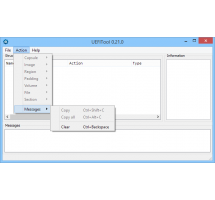

- #UEFITOOL ADD UEFI SHELL TO BIOS HOW TO#
- #UEFITOOL ADD UEFI SHELL TO BIOS DRIVER#
- #UEFITOOL ADD UEFI SHELL TO BIOS CODE#
- #UEFITOOL ADD UEFI SHELL TO BIOS FREE#
If you want to extract or replace just this functionally essential part of the EFI Module, you need resp.
#UEFITOOL ADD UEFI SHELL TO BIOS DRIVER#
#UEFITOOL ADD UEFI SHELL TO BIOS CODE#
This file with the FFS extension contains the complete code of the related EFI module (incl.
#UEFITOOL ADD UEFI SHELL TO BIOS HOW TO#
Since the UEFITool “maker” CodeRush himself hasn’t yet published detailed instructions regarding the usage of all specific UEFITool options, I decided to offer here a short guide just about how to insert/replace the most important EFI modules into an AMI UEFI BIOS. That is why I recommend to use the UEFITool, if you wantĪ) to insert a previously not present EFI module into a specific mainboard UEFI BIOS orī) to manually replace an already existing EFI module by another version or variant.
#UEFITOOL ADD UEFI SHELL TO BIOS FREE#
is free and can be used by everyone (since it is an “Open Source” project, there are no restrictions). it automaticly corrects the checksum of an FFS file while inserting/updating it) andģ. works absolutely precise and very safe (e.g.

can modify all “pure” (=extracted) AMI UEFI BIOS files (no matter whether its structure is Aptio IV or Aptio V),Ģ. Both tools have been developed and is still kept up-to-date by our Forum member CodeRush.Īt first view the usage of the UEFITool may not be as comfortable and easy to understand as the usage of the related AMI Aptio IV or Aptio V UEFI MMTool, but these are the benefits the users of the UEFITool will get:ġ. My favorite UEFI BIOS modding tool for these specific tasks is the normal “UEFITool” (don’t use the _NE variant for this purpose). (AMI) doesn’t allow to offer their AMI Aptio UEFI MMTools for the public, you may have to use another tool, if you want to manually modify an AMI UEFI BIOS according to your wishes. Since the company American Megatrends Inc. It’s also good practice for anyone that wants to learn how.All users, who want to manually optimize the UEFI BIOS of their manboard/system: You’ll have a simple user interface that makes your work easier, while you can also quickly export any of your work when you’re done. UEFITool delivers an outstanding service to those who find EUFI modifications tedious to make.

Change your EUFI firmware settings easily You can also share it online with other developers if you want to get their opinion on the modifications. Exporting imagesĪs the final step, you can export BIOS images and EUFI firmware configurations to your Windows device or an external USB. You can add and remove pieces as you see fit, as long as you know what you’re doing. Image types you can fiddle with include BIN, BIO, ROM, CAP, WPH, FD, and EFI. If you’re wondering about BIOS compatibility, you’ll be happy to know that there are many functions you can play with and enjoy. UEFITool presents the information to you in an easy-to-read format. Of course, you’ll need some basic knowledge of what you’re looking at before you can make any changes. Everything is laid out neatly for you in windows where you can find all the data you need. The first section that makes UEFI-changing life easier for you is the simple EUFITool interface.


 0 kommentar(er)
0 kommentar(er)
